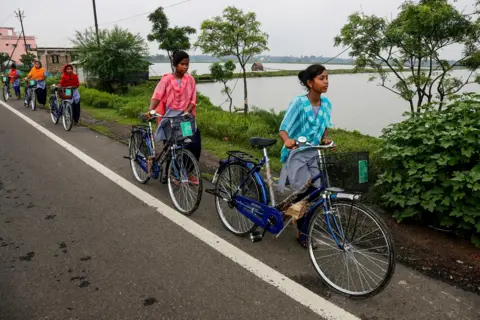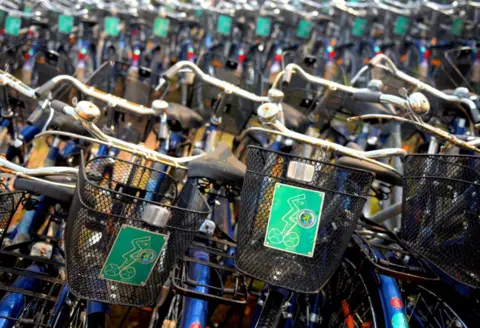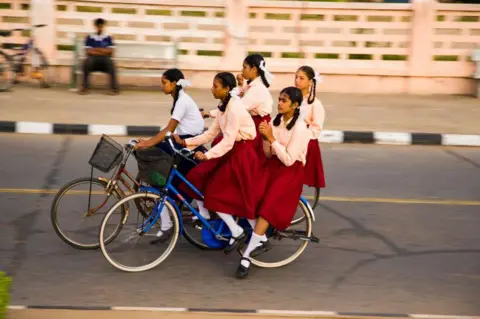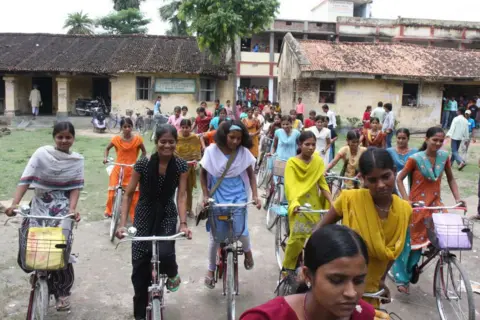India’s schoolgirls are leading a silent cycling revolution

 AP
APNibha Kumari, a resident of Bihar, India’s poorest state, recalls how a bicycle transformed her life when she turned 15.
For two years, six days a week, she cycled two hours daily from home to school and coaching classes and back, using a bicycle provided by the state government.
“If I didn’t have a cycle, I don’t think I could have finished high school. It changed my life,” says Nibha, now 27.
The daughter of a farmer from Begusarai district, Nibha was sent to live with her aunt 10km (six miles) away to attend a nearby primary school. Mobility was challenging for girls and public transport was unreliable.
When Nibha returned home for high school, she hopped on a bicycle, navigating the rough village roads to pursue her education.
“Girls have gained a lot of confidence after they began using bicycles to go to schools and coaching classes. More and more of them are going to school now. Most of them have free bicycles,” says Bhuvaneshwari Kumari, a health worker in Begusarai.
 Getty Images
Getty ImagesShe’s right. A new peer-reviewed study published in the journal ScienceDirect reveals remarkable insights about school-going children and cycling in rural India.
The study by Srishti Agrawal, Adit Seth and Rahul Goel found that the most notable rise in cycling in India had occurred among rural girls – increasing more than two times from 4.5% in 2007 to 11% in 2017 – reducing the gender gap in the activity.
“This is a silent revolution. We call it a revolution because cycling levels increased among girls in a country which has high levels of gender inequality in terms of female mobility outside the home, in general, and for cycling, in particular,” says Ms Agrawal.
State-run free bicycle distribution schemes since 2004 have targeted girls, who had higher school dropout rates than boys due to household chores and exhausting long walks. This approach isn’t unique to India – evidence from countries like Colombia, Kenya, Malawi and Zimbabwe also shows that bicycles effectively boost girls’ school enrolment and retention. But the scale here is unmatched.
The three researchers – from Delhi’s Indian Institute of Technology and Mumbai’s Narsee Monjee Institute of Management Studies – analysed transport modes for school-going children aged 5-17 years from a nationwide education survey, looked at the effectiveness of state-run schemes that provide free bicycles to students and tested their influence on the cycling rate.
 Getty Images
Getty ImagesNationally, the percentage of all students cycling to school rose from 6.6% in 2007 to 11.2% in 2017, they found.
Cycling to school in rural areas doubled over the decade, while in urban areas, it remained steady. Indian city roads are notoriously unsafe, with low urban cycling to school linked to poor traffic safety and more cars on the road.
India’s cycling revolution is most substantial in villages, with states like Bihar, West Bengal, Assam, and Chhattisgarh leading the growth. These states have populations comparable to some of the largest European countries. Cycling was most common for longer distances in rural areas than in urban areas, the study found.
India began reporting cycling behaviour for the first time only in the last Census in 2011. Only 20% of those travelling to work outside home reported cycling as their main mode of transport. But people in villages cycled more (21%) than in the cities (17%).
Also, more working men (21.7%) than their female counterparts (4.7%) cycled to work. “Compared to international settings, this level of gender gap in cycling is among the highest in the world,” says Ms Agrawal.
 Getty Images
Getty ImagesAmerican suffragist Susan B Anthony famously said that the bicycle “has done more to emancipate women than anything else in the world. It gives women a feeling of freedom and self-reliance”.
Researchers wonder if women cycle less as they age due to shrinking job opportunities and workforce dropout. Nibha stopped cycling after marriage and moving to her in-laws’ home. While she still travels outside the house as she trains to become a teacher, when asked about her commute, she simply says, “I don’t need the cycle anymore.”
Source link





